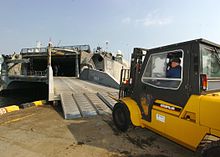HSV-2 Swift
As part of this program, she was directly leased for evaluation from her builders by the United States Navy Military Sealift Command from 2003 to 2013, primarily as a mine countermeasures and sea basing test platform.
In July 2015, the ship was leased by the United Arab Emirates National Marine Dredging Company and was used to carry aid through the Bab Al Mandab strait.
The minimum crew size is 35; during her time with the MSC 18 were military with the balance civilian, provided through American Maritime Officers and Seafarers International Union of the United States Merchant Marine.
On rare occasion that she was in a United States port, it was usually Naval Station Mayport, Florida, supporting the Fourth Fleet or Charleston, South Carolina, for major maintenance.
She was the second catamaran the Navy leased to test new technologies and concepts associated with the Chief of Naval Operations's "Sea Power 21" plan.
The Navy hoped to build upon lessons learned from Swift and her predecessor, and eventually use the information to create a new class of littoral combat ships.
[7] In the autumn of 2003, while operating with the Fifth Fleet, Swift completed the fastest-ever transit of the northern Great Barrier Reef from Cairns to Booby Island, Australia, averaging slightly over 39 knots (72 km/h).
[citation needed] In January 2005, Swift was tapped to provide logistical assistance during the tsunami relief effort in North Sumatra.
With most roads inaccessible along the Gulf Coast, Swift and her crew delivered the necessary supplies by water, traversing the Mississippi River multiple times hauling humanitarian aid between Pensacola, Florida, and New Orleans, Louisiana.
[18] The GFS pilot mission was completed on 30 September 2007, when Swift returned to Naval Station Mayport, Florida.
SPS is an annual deployment of various specialty platforms to the U.S. Southern Command (USSOUTHCOM) area of responsibility (AOR) in the Caribbean and Latin America.
The mission's primary goal is information sharing with navies, coast guards, and civilian services throughout the region.
[23] The ship was used to carry aid, wounded, and passengers as part of the Saudi-led intervention in Yemen through Bab Al Mandeb strait.
[1] On 1 October 2016, Iranian-backed rebel Houthis claimed to have attacked and sunk Swift off the Yemeni coast around Bab-el-Mandeb strait.
[citation needed] Unnamed U.S. Defense officials reported that four "shoulder-fired rockets" were used in the attack,[4] but Houthis said it was a C-802/Noor anti-ship missile.
[citation needed] According to open source naval analyst and retired Navy Captain Chris Carlson, the shrapnel damage to Swift indicates she was hit by EFP warhead, most likely a C-802.



